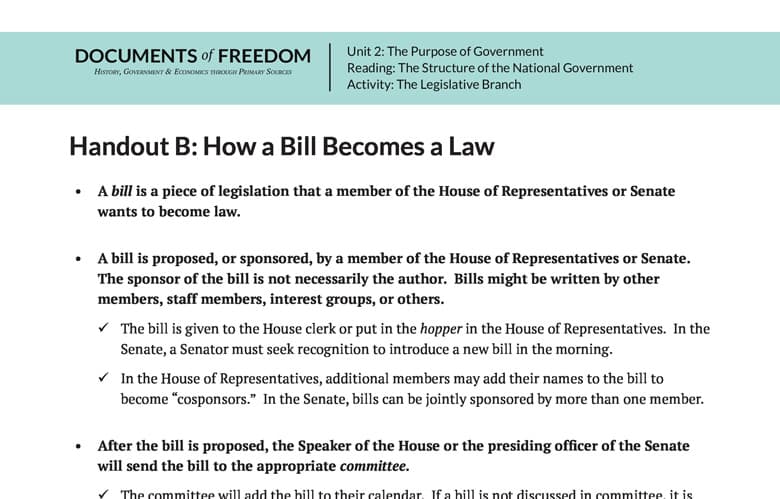Handout B: How A Bill Becomes A Law
Handout B: How a Bill Becomes a Law
- A bill is a piece of legislation that a member of the House of Representatives or Senate wants to become law.
- A bill is proposed, or sponsored, by a member of the House of Representatives or Senate. The sponsor of the bill is not necessarily the author. Bills might be written by other members, staff members, interest groups, or others.
- The bill is given to the House clerk or put in the hopper in the House of Representatives. In the Senate, a Senator must seek recognition to introduce a new bill in the morning.
- In the House of Representatives, additional members may add their names to the bill to become “cosponsors.” In the Senate, bills can be jointly sponsored by more than one member.
- After the bill is proposed, the Speaker of the House or the presiding officer of the Senate will send the bill to the appropriate committee.
- The committee will add the bill to their calendar. If a bill is not discussed in committee, it is effectively “killed.”
- The committee will hold hearings on the proposed bill or the chairperson of the committee may assign the bill to a subcommittee.
- After the bill is discussed, the full committee will vote on it. If the vote passes, the committee will made revisions or edits to the bill. After the edits are made, the committee must vote to accept the changes.
If major edits are made, the committee may decide to create a new bill which will start the process over from the beginning. - The committee will then write reports about why they are in favor of or against the bill. In the House, the bill will usually go to the Rules Committee for approval. The bill is then sent back to the main chamber of the House or Senate.
- When the bill returns to the main chamber, it is placed on the calendar for debate.
- When the bill comes up for debate, the House must follow the rules put in place by the Rules Committee when discussing the bill.
- In the Senate, debate is unlimited. Senators can debate the bill for as long as they want. Sometimes Senators will use a filibuster in which they continue to talk for hours to keep the bill from being passed. A filibuster can be limited by cloture or a three-fifths vote. Cloture limits the amount of time that a bill can be debated to thirty hours more.
- After the debate, the bill is voted on.
- In the House, there must be a quorum vote first to make sure there are enough members present to conduct the vote.
- If the bill passes, it is then sent to the other chamber for deliberation and voting again.
- If the bill does not pass either chamber, it dies.
- If there are two similar bills passed by both chambers, members will meet in a Conference Committee to attempt to come to an agreement about the bills. If the committee agrees, they will write a conference report that is sent to both chambers for approval.
- If both chambers pass the bill, it is sent on to the President to sign.
- If the president signs the bill, it becomes law.
- If the president vetoes (or rejects) the bill, it will be sent back to the chamber where it originated. Each chamber has to vote on the bill again and attain a two-thirds majority to override the veto.
- The president does not sign the bill within 10 days when Congress is in session, the bill automatically becomes law.
- If the president does not sign the bill within 10 days and Congress is not in session, the bill does not become law. This is called a pocket veto.
